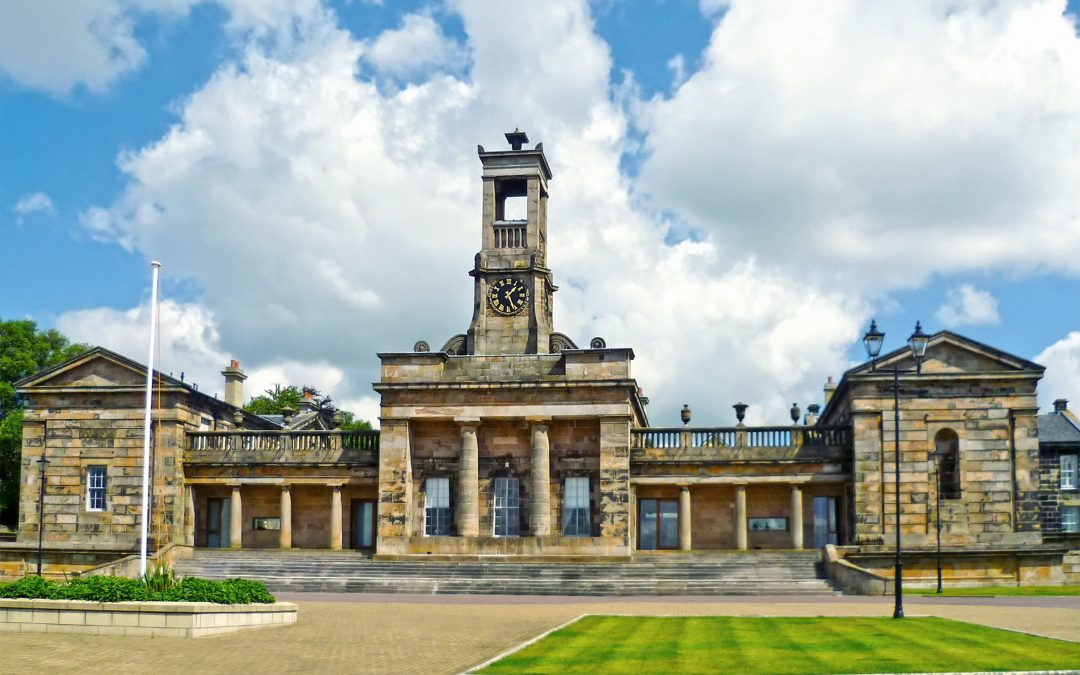Bathgate, a small town located in West Lothian, Scotland, has a rich history that dates back to the Roman occupation of the area. The town’s name is believed to have originated from the Old English words ‘bað’ and ‘gait’, meaning ‘bathing place’ and ‘road’ respectively. This suggests that Bathgate was once a popular destination for people seeking to bathe in the nearby streams.
The town’s history can be traced back to the 12th century when it was granted a royal charter by King Malcolm IV. This allowed Bathgate to hold weekly markets and annual fairs, which helped to boost its economy. Over the years, the town continued to grow and develop, with the construction of several notable buildings such as Bathgate Academy and the Bathgate Town Hall. Today, Bathgate is a thriving community that is home to over 15,000 people, and it continues to play an important role in the history and culture of West Lothian.
Early History
Bathgate is a town located in West Lothian, Scotland. The area has a rich history that dates back centuries. In this section, we will explore the early history of Bathgate, focusing on Bathgate Castle and the High Steward of Scotland.
Bathgate Castle
Bathgate Castle was a stronghold that was located in the town of Bathgate. The castle was built in the 12th century and was owned by various noble families over the centuries. The castle was destroyed during the Wars of Scottish Independence in the 14th century and was never rebuilt.
High Steward of Scotland
The High Steward of Scotland was an important position in medieval Scotland. The High Steward was responsible for overseeing the administration of the kingdom and was one of the most powerful people in the country. The first High Steward of Scotland was Walter Fitzalan, who held the position from 1150 to 1177. The position remained in the Fitzalan family until the 14th century.
John Bartholomew, a prominent cartographer from Edinburgh, wrote about Bathgate in his book “Gazetteer of the British Isles” in 1887. According to Bartholomew, Bathgate was a market town and had a population of around 4,000 people at the time. The town was known for its coal mining industry and had several coal mines in the surrounding area.
In 1921, Bathgate became the administrative center of the newly-formed county of Linlithgowshire. The town continued to grow throughout the 20th century and is now a thriving community with a population of over 15,000 people.
Industrial Revolution
During the Industrial Revolution, Bathgate was transformed from a small rural village into a bustling industrial town. The town’s location near coal, iron, and lime deposits made it a prime location for industry.
Coal Mining
Coal mining played a significant role in Bathgate’s industrial growth. The town had several coal mines, including the Boghead Colliery, which was one of the largest in Scotland. The coal was used to power the town’s factories and steelworks.
Steelworks
The arrival of the railway in Bathgate in 1849 made it easier to transport goods, and the town’s steel industry flourished. The Bathgate Foundry was established in 1840 and produced a range of products, including rails, pipes, and machinery. The foundry was later taken over by the Steel Company of Scotland, which became one of the largest steel producers in the country.
Glenmavis Distillery
Glenmavis Distillery was established in 1825 and produced whisky until it closed in 1929. The distillery was located near the Bathgate and Coatbridge Railway, which made it easy to transport the whisky to markets across Scotland.
Economic Developments
British Motor Corporation
Bathgate played a significant role in the British Motor Corporation’s (BMC) history. In 1961, the company opened a factory in Bathgate, which became one of the largest employers in the area. The factory produced a range of popular cars, including the Austin Cambridge, Morris Minor, and Mini. The factory closed in 1986, resulting in a significant loss of jobs for the local community.
British Leyland
Following BMC’s closure, British Leyland took over the factory. The company produced trucks and tractors at the site, which provided employment opportunities for the local community. However, the factory struggled with productivity and profitability, and it eventually closed in 1986, leading to a significant rise in unemployment in the area.
Bathgate Truck and Tractor Plant
The Bathgate Truck and Tractor Plant was established in 1986, following the closure of the British Leyland factory. The plant was operated by the American company, Navistar International, and produced a range of trucks and tractors. The plant provided employment opportunities for the local community until its closure in 2000.
Plessey
Plessey, a telecommunications company, opened a factory in Bathgate in the 1960s. The factory produced a range of electronic components and provided employment opportunities for the local community. However, the factory closed in the 1990s, leading to a loss of jobs in the area.
Motorola
Motorola established a factory in Bathgate in the 1990s, which produced a range of electronics products. The factory provided employment opportunities for the local community until its closure in 2001, following a decline in demand for its products.
Cultural and Social Aspects
Bathgate is a town with a rich cultural and social history. Over the years, it has become a hub for various cultural and social activities, which have contributed to its unique identity. This section will explore some of the significant cultural and social aspects of Bathgate, including the Bennie Museum and Regal Theatre.
Bennie Museum
The Bennie Museum is a local museum that showcases the history and heritage of Bathgate. It is located in a building that was once a public library and features a collection of artifacts and exhibits that tell the story of the town’s past. The museum has a range of exhibits, including displays on local industries, such as shale oil and coal mining, as well as exhibitions on the town’s social history.
The museum is a popular destination for tourists and locals alike, and it offers a range of educational programs and events throughout the year. It is run by a team of dedicated volunteers who are passionate about preserving Bathgate’s history and heritage.
Regal Theatre
The Regal Theatre is a historic cinema that has been a fixture of Bathgate’s cultural scene for over 80 years. The theatre was built in 1938 and has undergone several renovations over the years, but it still retains much of its original charm and character.
Today, the Regal Theatre is a popular venue for live music, theatre productions, and film screenings. It has a seating capacity of 500 and features state-of-the-art sound and lighting equipment. The theatre also hosts a range of community events, including dance classes, art exhibitions, and charity fundraisers.
Geography and Land Use
Edinburgh
Bathgate is a town located in West Lothian, Scotland, approximately 20 miles west of Edinburgh. The town is situated on the main railway line between Edinburgh and Glasgow, which makes it an important transport hub for the region. Edinburgh is the capital city of Scotland and is located to the east of Bathgate. It is a major cultural, financial, and political centre in Scotland.
Linlithgow
Linlithgow is a historic royal burgh located approximately 4 miles east of Bathgate. The town is situated on the southern shore of Linlithgow Loch and is home to many historic buildings, including Linlithgow Palace, the birthplace of Mary Queen of Scots. The town is also known for its annual Marches Day celebrations, which take place in June.
Livingston
Livingston is a large town located approximately 5 miles east of Bathgate. It is the largest town in West Lothian and is home to many large retail parks, including The Centre and Livingston Designer Outlet. The town has a population of approximately 55,000 and is a major employment centre in the region.
Land Use
The land use in Bathgate and the surrounding area is primarily agricultural, with many farms and fields located in the surrounding countryside. The town itself is predominantly residential, with a mix of traditional and modern housing. There are also many industrial estates located in and around Bathgate, which provide employment opportunities for local residents.
Demographics
Bathgate is a town located in West Lothian, Scotland, with a population of approximately 17,000 people. The town has seen a steady increase in population over the last few decades, with the number of residents rising by 4.5% since the last census in 2011.
The majority of the population in Bathgate is of White British ethnicity, with a small percentage of individuals identifying as Asian, Black, or from other ethnic groups. The town is also home to a significant number of Polish immigrants, who have settled in the area over the last few years.
In terms of age demographics, Bathgate has a relatively even split between younger and older residents. Approximately 22% of the population is under the age of 18, while 20% are over the age of 65.
Bathgate is part of the Livingston constituency, which is represented in the UK Parliament by Hannah Bardell of the Scottish National Party. The town is also part of the Lothian region in the Scottish Parliament, which is represented by several Members of Scottish Parliament (MSPs) from different political parties.
Historical Documentation
Ordnance Gazetteer of Scotland
The Ordnance Gazetteer of Scotland is a historical document that provides valuable information on the history of Bathgate. It was published in 1885 and contains detailed descriptions of the town, its geography, and its people. The Gazetteer provides a wealth of information on the town’s history, including its early development, its growth as a centre of industry, and its role in the wider history of Scotland.
Gazetteer of the British Isles
The Gazetteer of the British Isles is another important historical document that provides insight into the history of Bathgate. Published in 1887, it contains detailed descriptions of the town and its surroundings, including its geography, history, and people. The Gazetteer provides a comprehensive overview of the town’s history, including its role in the wider history of Scotland and the United Kingdom.
Royal Commission on the Ancient and Historical Monuments of Scotland
The Royal Commission on the Ancient and Historical Monuments of Scotland is a government agency responsible for the recording, interpretation, and protection of Scotland’s built heritage. The Commission has conducted extensive research on Bathgate and its historical sites, including its castles, churches, and other important landmarks. The Commission’s work has helped to preserve Bathgate’s rich history for future generations.
Archive
The Archive is a collection of historical documents, photographs, and other materials related to the history of Bathgate. It contains a wealth of information on the town’s history, including its early development, its growth as a centre of industry, and its role in the wider history of Scotland. The Archive is an important resource for historians, researchers, and anyone interested in the history of Bathgate.
In conclusion, Bathgate’s rich history is well-documented in a variety of historical documents, including the Ordnance Gazetteer of Scotland, the Gazetteer of the British Isles, the Royal Commission on the Ancient and Historical Monuments of Scotland, and the Archive. These documents provide valuable insights into the town’s history, and help to preserve its heritage for future generations.

